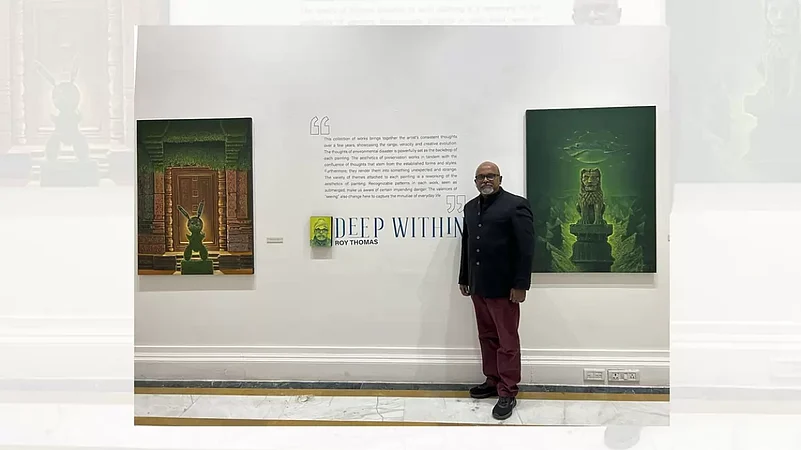How will the famous sculptures and monuments look if, a few hundred years from now, the world goes underwater? Will people on the land then remember them anymore or will it all be forgotten? Like the lost cities of Mohenjo Daro, Dwarka, and Port Royal, will archaeologists, decades later, discover underwater these precious figurines that we claim to preserve and honour today?
A solo exhibition titled ‘Deep Within’ (Arushi Arts) by Delhi-based artist Roy Thomas addressed the fast-changing climate conditions, what he calls the “anxieties” of possible realities. Using the oil medium, he invites us to bear witness to a hypothetical world within the depths of the ocean and compels us to look within ourselves and question our neglect towards nature and society.
For the past few years, artists around the world have been overcompensating for the lost time with dozens of art shows confronting climate change. Why now? Maybe, it is because of the rampant wildfires and heatwaves, or because of the unpredictable weather conditions. The truth is that artists have realised the need to address the issue directly and now. While some choose to rail against the societal indifferences explicitly, others prefer to be more subtle.
Roy focuses on some of the most famous sculptures from around the world, historical and contemporary. In one of his paintings, we see the Statue of Liberty submerged in the ocean with an anchor reaching it and divers swimming around it. Befittingly, he calls it the “Unliberated ocean". In his version of a forgotten Michelangelo’s La Pieta, we see Jesus and Mary sunken in the bedrocks; in Auguste Rodin’s famous nude bronze The Thinker contemplating in the deep waters as light casts a halo on him.

“The things we celebrate right now calling them the most precious, whether an idol or an object or a building. Whatever it is, it has an age after which it will disappear before our eyes,” Roy says. “Be it Michaelangelo’s sculptures or Didarganj Yakshi, right now these are the sculptures which are very precious to us. We keep them in museums. But can go underwater due to the fast-changing climate and due to global warming. Those who have the knowledge, are very seriously discussing it.”
An art graduate from Thiruvananthapuram, Kerala, and a postgraduate from the College of Art, Delhi, Thomas has been painting for as early as he can remember. Over the past three decades, he has conducted many art shows across continents and won several accolades for it. He draws inspiration from history, contemporary and spirituality, and connects it with the hyperrealities of our lives.
“I read about the Statue of Liberty going underwater in some 23,000 years. And look how tall it is. Imagine the rise in water level for that to happen. That’s when I thought I’d paint these sculptures underwater,” Roy says.
Roy’s paintings often address many burning issues. “Everything is political,” he says, adding that although sometimes he approaches a painting with a newspaper clipping in his mind, other times it just happens to become a topic of political discussion. “More than the political, my concern is about humanity. I feel that it is very normal, considering the world around us and I am just very aware of it. My paintings are not to show whose side I’m on but rather about my ideology which is something more humanitarian,” he elaborates.
The Deep Within collection also showcased Roy’s version of the lion capital from Ashoka’s period submerged to the ocean floor; the statues of Mahatma Gandhi, Gautam Buddha, and that of BR Ambedkar, fallen into the abyssal depths. Like their fading ideologies, what if their statues are also forgotten?

Environmentalist Bill McKibben, in an op-ed in Grist, made some of the most striking points about global warming. He says, “If the scientists are right, we’re living through the biggest thing that’s happened since human civilization emerged…But oddly, though we know about it, we don’t know about it. It hasn’t registered in our gut; it isn’t part of our culture.”
In 2015, for his solo exhibition titled ‘Uninterrupted Tales’, Roy made a pointed political statement with a central theme of innocence against the backdrop of peace and violence, jungle and civilisation. One of his paintings in that collection was of a newborn sleeping on shattered glass in the Gaza conflict zone. When asked if he chooses to juxtapose this sense of calmness with such grave issues, Roy says that he simply presents the spiritual nature of the objects he is representing. However, he makes a poignant remark questioning the need for violent arguments. “We need more peaceful talks. We need negotiations through discussions.”

Perhaps, art can also be that platform to negotiate through discussions. Many artists around the world have tried to build a climate consciousness among their audience through their art. In 2018, at Times Square, New York City, a climate-change scenarios art project showed how the city would look by 2100 when water levels are expected to rise by up to six feet. Through a downloadable app, Mel Chin’s “Unmoored” makes people look up through their phones to experience an incoming flotilla of boats around existing buildings, creating a nautical traffic jam.
Other famous artists who address climate change through their art include Icelandic artist Olafur Eliasson, who creates completely immersive installations to make viewers re-connect with their natural environment; Stacy Levvy and her large-scale sculptural works that focus on ecological degradation and environmental issues; Cai Guo Qiang, who is known for his innovative and politically charged installations to examine the societal problems of his homeland; and many others.
All these artists, who have understood the gravity of the matter, have only one thing to tell their audience: we’re losing time. The world we see before us is dying. We need to register it in our imaginations, and art can only help so much with that. In McKibben’s words: “Therefore, it falls to those of us alive now to watch and record its flora, its fauna, its rains, its snow, its ice, its peoples. To document the buzzing, glorious, cruel, mysterious planet we were born onto, before in our carelessness we leave it far less sweet.”


























